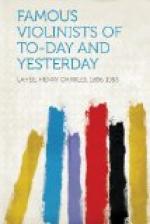His grisly beard was long and thick,
With which he strung his fiddle-stick;
For he to horse-tail scorned to owe,
For what on his own chin did grow.”
Many years later Purcell, the composer, wrote a catch in which the merits of a violin maker named Young, and his son, a violin player, are recorded. The words are as follows:
“You scrapers that want a good fiddle,
well strung,
You must go to the man that is old while
he’s Young;
But if this same Fiddle, you fain would
play bold,
You must go to his son, who’ll be
Young when he’s old.
There’s old Young and young Young,
both men of renown,
Old sells and young plays the best Fiddle
in town,
Young and old live together, and may they
live long,
Young to play an old Fiddle; old to sell
a new song.”
In the course of time the English learned to esteem all arts more highly, and in no country was a great musician more sure of a warm welcome.
Two celebrated violinists were born in the year 1630, Thomas Baltzar, and John Banister, the former in Germany, at Lubec, and the latter in London.
Baltzar was esteemed the finest performer of his time, and is said to have been the first to have introduced the practice of “shifting.” In 1656 Baltzar went to England, where he quite eclipsed Davis Mell, a clockmaker, who was considered a fine player, and did much to give the violin an impetus toward popularity. The wonder caused by his performances in England, shortly after his arrival, is best described in the quaint language of Anthony Wood, who “did, to his very great astonishment, hear him play on the violin. He then saw him run up his Fingers to the end of the Fingerboard of the Violin, and run them back insensibly, and all with alacrity, and in very good tune, which he nor any in England saw the like before.”
At the Restoration Baltzar was appointed leader of the king’s celebrated band of twenty-four violins, but, sad to relate, “Being much admired by all lovers of musick, his company was therefore desired; and company, especially musical company, delighting in drinking, made him drink more than ordinary, which brought him to his grave.” And he was buried in the cloister of Westminster Abbey.
John Banister was taught music by his father, one of the waits of the parish of St. Giles, and acquiring great proficiency on the violin was noticed by King Charles II., who sent him to France for improvement. On his return he was appointed chief of the king’s violins. King Charles was an admirer of everything French, and he appears, according to Pepys, to have aroused the wrath of Banister by giving prominence to a French fiddler named Grabu, who is said to have been an “impudent pretender.” Banister lost his place for saying, either to or in the hearing of the king, that English performers on the violin were superior to those of France.




